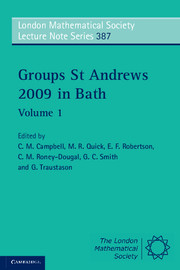Book contents
- Frontmatter
- Contents
- Introduction
- A speech in honour of John Cannon and Derek Holt
- Finite groups of Lie type and their representations
- Iterated monodromy groups
- Engel elements in groups
- Some classes of finite semigroups with kite-like egg-boxes of D-classes
- Structure of finite groups having few conjugacy class sizes
- Group theory in cryptography
- A survey of recent results in groups and orderings: word problems, embeddings and amalgamations
- A survey on the minimum genus and maximum order problems for bordered Klein surfaces
- On one-relator quotients of the modular group
- Miscellaneous results on supersolvable groups
- Automorphisms of products of finite groups
- A rational property of the irreducible characters of a finite group
- Automotives
- On n-abelian groups and their generalizations
- Computing with matrix groups over infinite fields
- Trends in infinite dimensional linear groups
- Engel conditions on orderable groups and in combinatorial problems (a survey)
- References
Structure of finite groups having few conjugacy class sizes
Published online by Cambridge University Press: 05 July 2011
- Frontmatter
- Contents
- Introduction
- A speech in honour of John Cannon and Derek Holt
- Finite groups of Lie type and their representations
- Iterated monodromy groups
- Engel elements in groups
- Some classes of finite semigroups with kite-like egg-boxes of D-classes
- Structure of finite groups having few conjugacy class sizes
- Group theory in cryptography
- A survey of recent results in groups and orderings: word problems, embeddings and amalgamations
- A survey on the minimum genus and maximum order problems for bordered Klein surfaces
- On one-relator quotients of the modular group
- Miscellaneous results on supersolvable groups
- Automorphisms of products of finite groups
- A rational property of the irreducible characters of a finite group
- Automotives
- On n-abelian groups and their generalizations
- Computing with matrix groups over infinite fields
- Trends in infinite dimensional linear groups
- Engel conditions on orderable groups and in combinatorial problems (a survey)
- References
Summary
Abstract
The structure of finite groups has a significant influence on the conjugacy class sizes and reciprocally is also influenced by them. In this paper we present some classic and recent contributions which have been obtained during the last forty years related to the structure and properties of those groups having few conjugacy class sizes.
Introduction
The structure of a finite group strongly controls and at the same time is controlled by the sizes of its conjugacy classes and this relation also occurs for the degrees of its irreducible characters. If G is a finite group, we will denote by cs(G) the set of the conjugacy class sizes of G and by cd(G) the set of its irreducible character degrees. It is accepted that there exists certain parallelism between the results accomplished on the group structure from its character degrees and the ones obtained from its class sizes, although the techniques employed to show them may be completely different. We focus our attention to the cardinals of these sets. The fact that they are small for a group may provide a lot of information about it, but we observe that apparently there seems to be no relation between them. For instance, we have that G = SL(2, 5) satisfies |cs(G)| = 4 and |cd(G)| = 6, and that G = A7 satisfies |cs(G)| = 8 and |cd(G)| = 7, whereas the equality holds for G = A5 since |cs(G)| = |cd(G)| = 4.
- Type
- Chapter
- Information
- Groups St Andrews 2009 in Bath , pp. 124 - 132Publisher: Cambridge University PressPrint publication year: 2011

